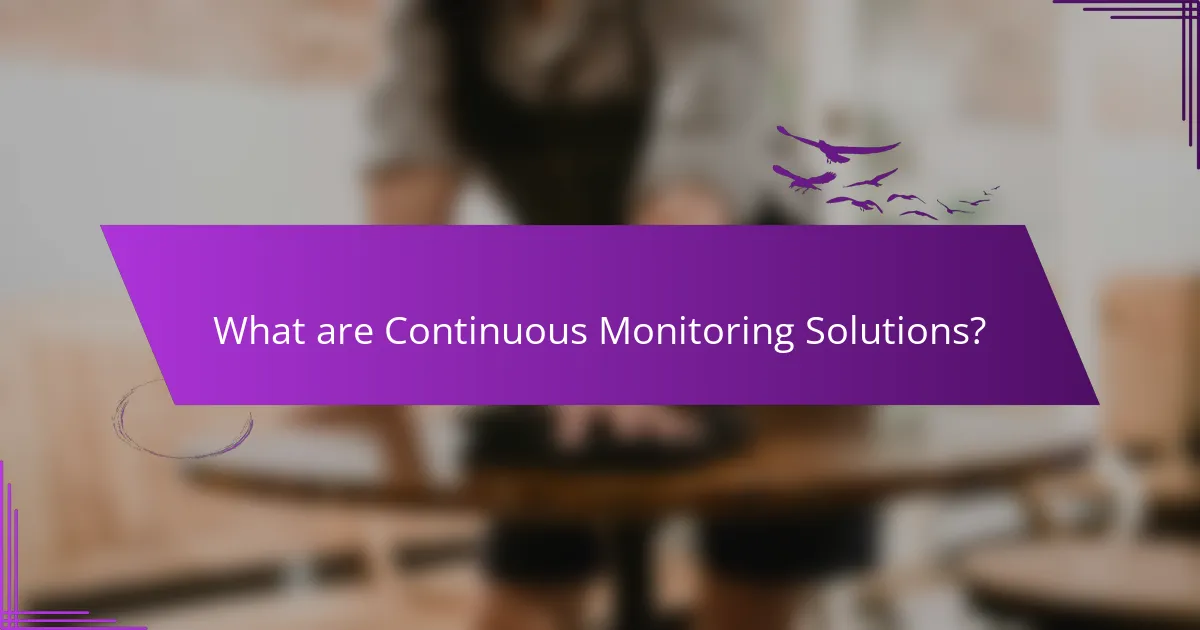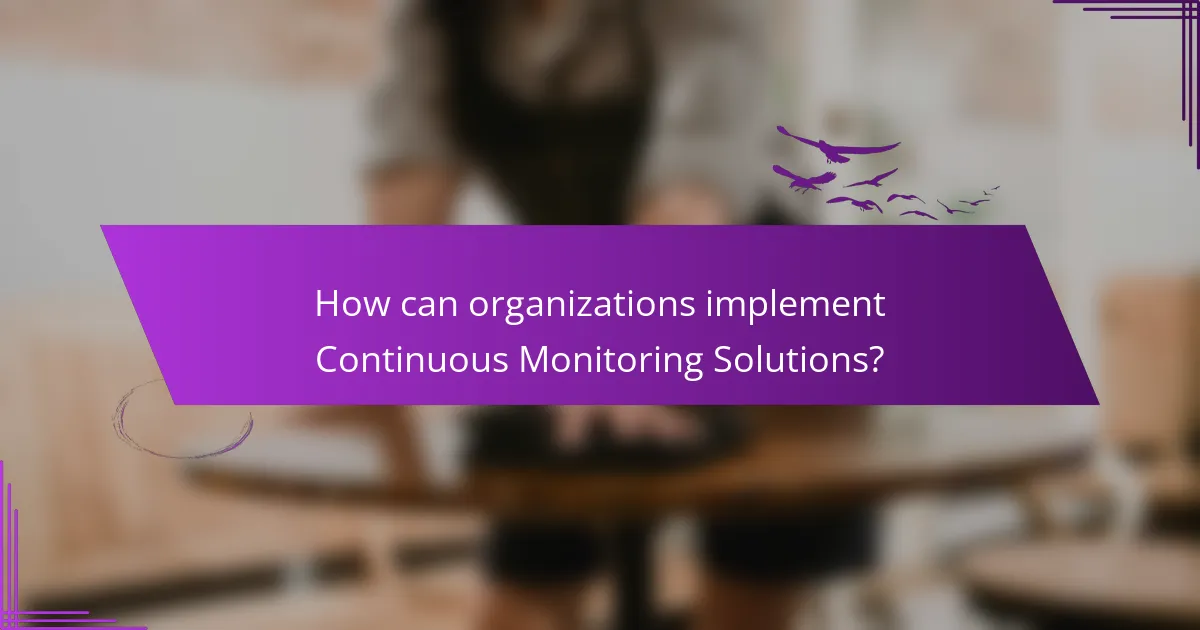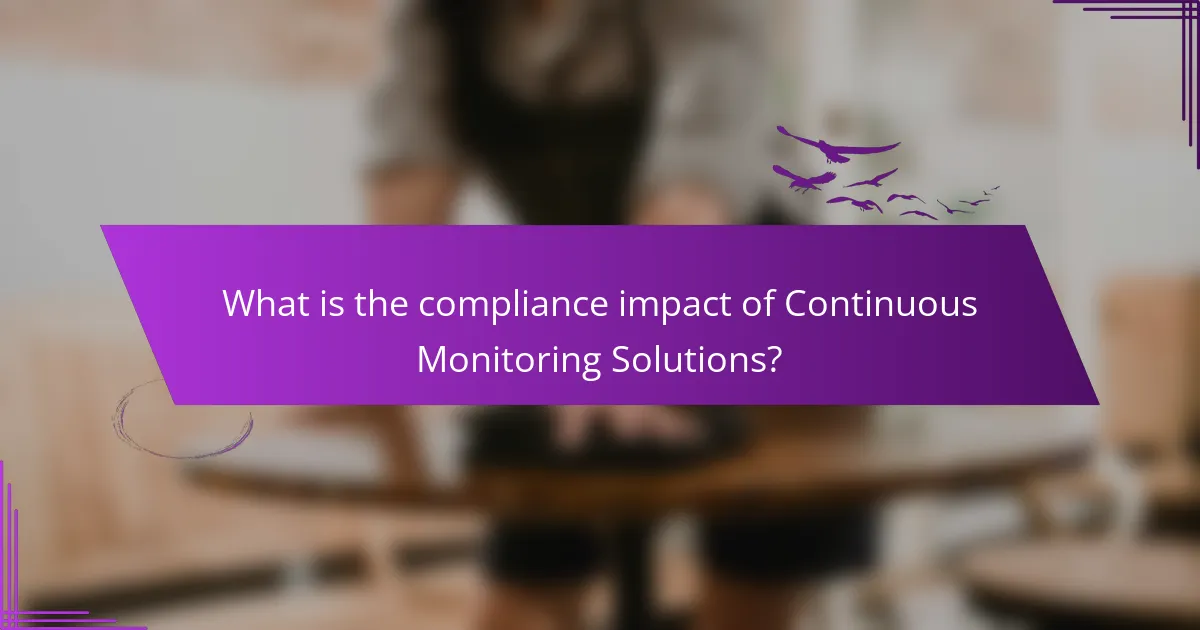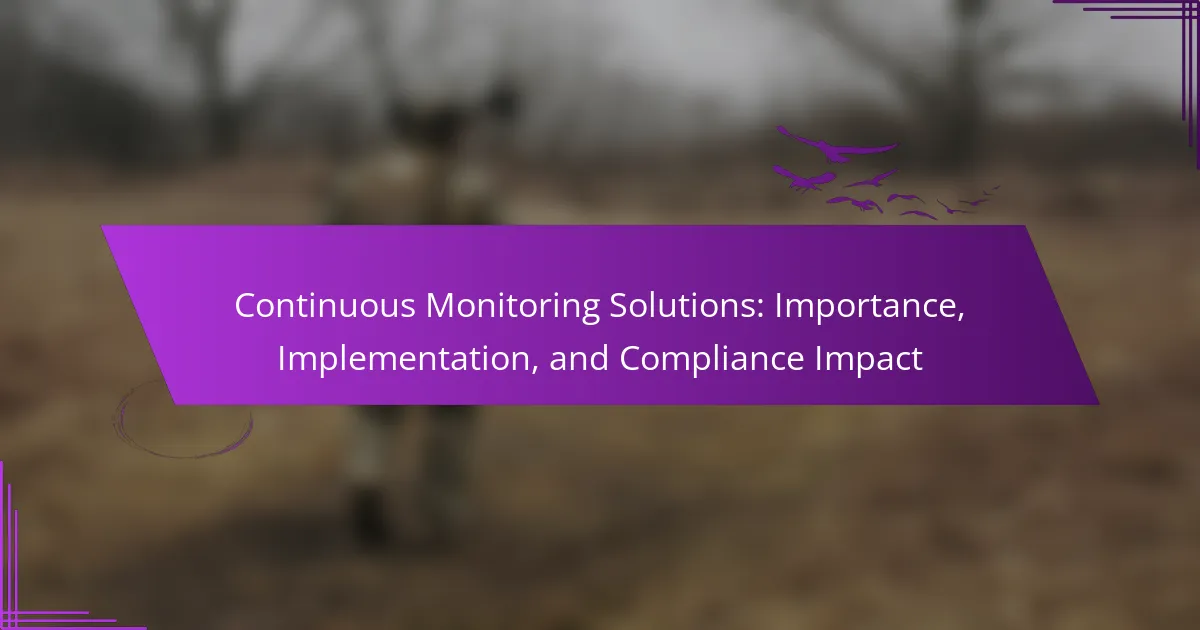
What are Continuous Monitoring Solutions?
Continuous Monitoring Solutions are tools and processes that provide real-time oversight of systems and environments. They enable organizations to detect and respond to changes or anomalies promptly. These solutions often integrate automated technologies to streamline monitoring tasks. They are essential for maintaining compliance and security in various industries. For instance, financial institutions use continuous monitoring to adhere to regulations. This approach reduces the risk of breaches and enhances operational efficiency. Continuous Monitoring Solutions also support proactive risk management strategies. They help organizations stay ahead of potential threats and vulnerabilities.
How do Continuous Monitoring Solutions function?
Continuous Monitoring Solutions function by continuously collecting and analyzing data from various systems and processes. They utilize automated tools to monitor network activity, system performance, and compliance with security policies. These solutions provide real-time alerts for any anomalies or potential threats. They integrate with existing IT infrastructure to ensure seamless data flow. Continuous monitoring enables organizations to proactively identify vulnerabilities and mitigate risks. By analyzing trends over time, these solutions help in maintaining compliance with regulatory standards. Research shows that organizations employing continuous monitoring can reduce incident response times significantly.
What technologies are used in Continuous Monitoring Solutions?
Continuous Monitoring Solutions utilize various technologies for effective operation. Key technologies include network monitoring tools, which track data traffic and identify anomalies. Endpoint detection and response (EDR) solutions monitor devices for suspicious activities. Security information and event management (SIEM) systems aggregate and analyze security data from multiple sources. Cloud monitoring tools oversee cloud-based resources and applications for compliance and performance. Additionally, automation technologies facilitate real-time alerts and responses to threats. These technologies collectively enhance the security posture of organizations by enabling timely detection and response to potential risks.
What data is collected through Continuous Monitoring Solutions?
Continuous Monitoring Solutions collect various types of data to assess system performance and security. This data includes network traffic patterns, system logs, and user activity metrics. It also encompasses configuration changes and compliance status reports. Continuous Monitoring Solutions track vulnerabilities and threats in real-time. The data collected helps organizations maintain regulatory compliance and enhance security posture. Specific examples include intrusion detection alerts and application performance metrics. This data is crucial for proactive risk management and incident response.
Why are Continuous Monitoring Solutions important?
Continuous Monitoring Solutions are important because they provide real-time insights into system performance and security. These solutions enable organizations to detect anomalies and vulnerabilities promptly. By continuously analyzing data, they help in mitigating risks before they escalate into significant issues. Research indicates that organizations implementing continuous monitoring can reduce incident response times by up to 50%. Furthermore, continuous monitoring supports compliance with regulatory requirements, ensuring that organizations adhere to industry standards. This proactive approach to risk management enhances overall operational efficiency and strengthens organizational resilience.
What benefits do Continuous Monitoring Solutions provide to organizations?
Continuous Monitoring Solutions enhance organizational security and compliance. They provide real-time visibility into system vulnerabilities. This helps organizations identify threats promptly. Faster detection reduces potential damage from security incidents. Continuous monitoring also ensures compliance with regulatory standards. Organizations can demonstrate adherence through consistent reporting. Additionally, these solutions improve operational efficiency. They automate routine security tasks, freeing up resources. Overall, they contribute to a proactive security posture.
How do Continuous Monitoring Solutions enhance operational efficiency?
Continuous Monitoring Solutions enhance operational efficiency by providing real-time insights into system performance and security. They facilitate immediate detection of anomalies and potential issues. This proactive approach reduces downtime and minimizes disruptions. Organizations can make informed decisions quickly based on accurate data. Continuous monitoring also streamlines compliance with regulatory requirements. By automating data collection and reporting, these solutions save time and resources. Studies show that companies implementing continuous monitoring experience up to a 30% increase in operational efficiency. This improvement is attributed to faster response times and reduced manual oversight.

How can organizations implement Continuous Monitoring Solutions?
Organizations can implement Continuous Monitoring Solutions by following a structured approach. First, they need to define their monitoring objectives clearly. This involves identifying what assets, processes, or compliance requirements need oversight. Next, organizations should select appropriate monitoring tools that align with their objectives. These tools can range from automated software to manual processes, depending on the complexity of the environment.
Subsequently, organizations should establish baseline metrics for normal operations. This helps in identifying anomalies and potential security threats effectively. Training staff on the use of monitoring solutions is also essential. Proper training ensures that team members can interpret data correctly and respond to alerts effectively.
After implementation, organizations must regularly review and update their monitoring strategies. This ensures that the solutions remain effective against evolving threats. Continuous feedback loops should be established to refine processes based on the insights gained from monitoring activities. By adhering to these steps, organizations can create a robust Continuous Monitoring Solution that enhances their security posture and compliance readiness.
What steps are involved in implementing Continuous Monitoring Solutions?
The steps involved in implementing Continuous Monitoring Solutions include defining objectives, selecting tools, and establishing processes. First, organizations must define their monitoring objectives based on regulatory requirements and risk management goals. Next, they should select appropriate monitoring tools that align with these objectives. These tools can include software for automated data collection and analysis. After selecting tools, organizations need to establish processes for data collection, analysis, and reporting. This includes determining data sources and frequency of monitoring. Training staff on the new tools and processes is also crucial for effective implementation. Finally, organizations should continuously evaluate and refine their monitoring approach to adapt to changing conditions and compliance requirements.
How do organizations assess their needs for Continuous Monitoring Solutions?
Organizations assess their needs for Continuous Monitoring Solutions by evaluating their risk management requirements. They identify critical assets and potential vulnerabilities within their infrastructure. Organizations conduct a thorough analysis of regulatory compliance obligations. This includes understanding industry standards and legal requirements. They also consider the volume and sensitivity of data being handled. Assessing current monitoring capabilities is essential to identify gaps. Organizations may perform a cost-benefit analysis to determine resource allocation. Additionally, engaging with stakeholders can provide insights into monitoring needs. This structured approach ensures tailored solutions that align with organizational objectives.
What challenges might organizations face during implementation?
Organizations may face several challenges during the implementation of continuous monitoring solutions. These challenges include resistance to change from employees. Employees may be accustomed to existing processes and hesitant to adopt new technologies. Additionally, integration with existing systems can be complex. Organizations often struggle to ensure that new solutions work seamlessly with legacy systems.
Budget constraints can also pose a significant challenge. Organizations may have limited financial resources to allocate for new technologies. Furthermore, a lack of skilled personnel can hinder effective implementation. Many organizations find it difficult to recruit or train staff with the necessary expertise.
Data privacy and security concerns are critical during implementation. Organizations must ensure that monitoring solutions comply with regulations to protect sensitive information. Lastly, ongoing maintenance and support can be demanding. Continuous monitoring solutions require regular updates and monitoring to function effectively.
What best practices should organizations follow during implementation?
Organizations should follow structured planning, stakeholder engagement, and continuous feedback during implementation. Structured planning involves defining clear objectives and timelines. This helps in aligning resources effectively. Stakeholder engagement ensures that all relevant parties are informed and included. Engaging stakeholders fosters collaboration and minimizes resistance. Continuous feedback allows for real-time adjustments. This helps in addressing issues promptly and improving outcomes. Research indicates that organizations with these practices see a 30% increase in project success rates (Project Management Institute, 2021).
How can organizations ensure successful integration of Continuous Monitoring Solutions?
Organizations can ensure successful integration of Continuous Monitoring Solutions by establishing clear objectives and requirements. They should assess existing systems and identify gaps that need to be addressed. Engaging stakeholders early in the process is crucial for alignment and buy-in. Training staff on the new systems enhances effectiveness and reduces resistance. Regularly updating and maintaining the monitoring tools ensures they remain effective. Additionally, organizations should implement feedback mechanisms to continuously improve the integration process. Studies show that organizations with defined strategies see a 30% higher success rate in implementation.

What is the compliance impact of Continuous Monitoring Solutions?
Continuous Monitoring Solutions enhance compliance by providing real-time data and insights. They allow organizations to identify and address compliance issues proactively. Automated alerts and reports ensure timely responses to potential violations. This leads to reduced risks of non-compliance penalties. According to a study by the Ponemon Institute, organizations using continuous monitoring reduce compliance costs by up to 30%. Continuous Monitoring Solutions also facilitate adherence to regulatory requirements by tracking changes in compliance status. This ongoing oversight helps maintain a culture of compliance within organizations. Overall, these solutions significantly improve compliance management and accountability.
How do Continuous Monitoring Solutions help with regulatory compliance?
Continuous Monitoring Solutions assist with regulatory compliance by providing real-time oversight of systems and processes. They continuously track compliance-related metrics and flag deviations instantly. This proactive approach helps organizations identify and rectify compliance issues before they escalate. Automated reporting features streamline documentation for audits and regulatory reviews. Continuous Monitoring Solutions ensure adherence to industry standards such as GDPR and HIPAA. By maintaining up-to-date compliance status, organizations can avoid penalties and enhance operational efficiency. Studies indicate that companies using these solutions experience a 30% reduction in compliance-related incidents.
What specific regulations can Continuous Monitoring Solutions assist in meeting?
Continuous Monitoring Solutions can assist in meeting several specific regulations. These include the Health Insurance Portability and Accountability Act (HIPAA) for protecting patient data. They also help comply with the Federal Information Security Management Act (FISMA) for securing federal information systems. Additionally, Continuous Monitoring Solutions support adherence to the Sarbanes-Oxley Act (SOX) for financial reporting integrity. They facilitate compliance with the General Data Protection Regulation (GDPR) for data privacy in the European Union. Furthermore, these solutions aid in meeting the Payment Card Industry Data Security Standard (PCI DSS) for safeguarding payment card information. Each of these regulations requires ongoing monitoring of systems and data, which Continuous Monitoring Solutions effectively provide.
How can Continuous Monitoring Solutions mitigate compliance risks?
Continuous Monitoring Solutions mitigate compliance risks by providing real-time oversight of regulatory adherence. They enable organizations to identify compliance gaps promptly. This proactive approach reduces the likelihood of regulatory violations. Continuous monitoring employs automated tools to track compliance metrics consistently. These tools generate alerts for any deviations from compliance standards. Studies show that organizations using continuous monitoring reduce compliance-related fines by up to 30%. By maintaining an ongoing review process, businesses can swiftly adapt to changing regulations. This adaptability is crucial in today’s dynamic regulatory environment.
What are the potential consequences of non-compliance when using Continuous Monitoring Solutions?
Non-compliance when using Continuous Monitoring Solutions can lead to significant risks and penalties. Organizations may face legal repercussions, including fines and sanctions. Non-compliance can also result in data breaches, compromising sensitive information. This can damage an organization’s reputation and erode customer trust. Additionally, it may lead to operational inefficiencies due to a lack of timely insights. Regulatory bodies may impose stricter oversight on non-compliant organizations. In some cases, non-compliance can result in loss of business opportunities. Lastly, organizations may incur increased costs related to remediation efforts and compliance audits.
How can organizations prepare for compliance audits with Continuous Monitoring Solutions?
Organizations can prepare for compliance audits with Continuous Monitoring Solutions by implementing systematic monitoring processes. They should establish clear compliance requirements based on regulations relevant to their industry. Continuous monitoring tools can automate data collection and analysis to ensure real-time compliance status. Organizations must regularly review and update their monitoring systems to adapt to changing regulations. Training staff on compliance protocols is essential for effective monitoring. Documentation of monitoring activities provides an audit trail for compliance verification. Regular internal audits can identify gaps in compliance and allow for timely remediation. These practices enhance overall compliance readiness and reduce the risk of audit failures.
What are the future trends in Continuous Monitoring Solutions?
Future trends in Continuous Monitoring Solutions include increased automation, enhanced AI integration, and real-time data analytics. Automation reduces manual effort and improves efficiency. AI enhances predictive capabilities, allowing for better anomaly detection. Real-time analytics provide immediate insights, facilitating quicker decision-making. Additionally, there is a growing emphasis on regulatory compliance and risk management. Organizations are prioritizing solutions that ensure adherence to industry standards. The shift towards cloud-based monitoring solutions is also notable, offering scalability and flexibility. These trends reflect the evolving landscape of continuous monitoring in response to technological advancements and regulatory demands.
How might advancements in technology impact Continuous Monitoring Solutions?
Advancements in technology significantly enhance Continuous Monitoring Solutions. They improve data collection methods, enabling real-time analysis. Enhanced algorithms allow for more accurate threat detection. Automation reduces human error in monitoring processes. Cloud computing facilitates scalable storage and access to large datasets. Machine learning algorithms can identify patterns and anomalies more efficiently. These technological improvements lead to faster response times to security incidents. Overall, technology advancements drive more effective and reliable Continuous Monitoring Solutions.
What emerging threats should Continuous Monitoring Solutions address?
Continuous Monitoring Solutions should address emerging threats such as advanced persistent threats (APTs), zero-day vulnerabilities, and insider threats. APTs involve prolonged and targeted cyberattacks that can evade traditional security measures. Zero-day vulnerabilities are unknown software flaws that hackers exploit before developers release fixes. Insider threats come from employees or contractors misusing access to sensitive data. These threats are increasingly sophisticated and can lead to significant data breaches. According to a 2022 report by Cybersecurity Ventures, global cybercrime damages are projected to reach $10.5 trillion annually by 2025, highlighting the urgency for effective monitoring solutions. Continuous Monitoring Solutions can provide real-time detection and response capabilities to mitigate these risks.
What practical tips can organizations use to maximize the effectiveness of Continuous Monitoring Solutions?
Organizations can maximize the effectiveness of Continuous Monitoring Solutions by implementing several practical tips. First, they should establish clear objectives for monitoring. This ensures that the monitoring aligns with organizational goals. Second, organizations must select the right tools that fit their specific needs. Tools should offer scalability and integration capabilities. Third, regular training for staff is essential. Well-trained personnel can effectively interpret monitoring data. Fourth, organizations should prioritize real-time data analysis. This allows for quicker response to potential issues. Fifth, they must ensure compliance with relevant regulations. Adhering to standards minimizes legal risks. Finally, organizations should continuously review and update their monitoring strategies. This helps adapt to evolving threats and business environments. These practices are supported by industry reports showing improved security outcomes with effective monitoring strategies.
Continuous Monitoring Solutions are tools and processes designed for real-time oversight of systems and environments, enabling organizations to detect and respond to anomalies promptly. This article explores the importance of these solutions in enhancing compliance and security across various industries, detailing their functionality, key technologies, and the types of data they collect. It also outlines best practices for implementation, potential challenges, and the compliance impact of continuous monitoring, emphasizing its role in risk management and operational efficiency. Additionally, the article addresses future trends and emerging threats that Continuous Monitoring Solutions must tackle to maintain organizational resilience.
